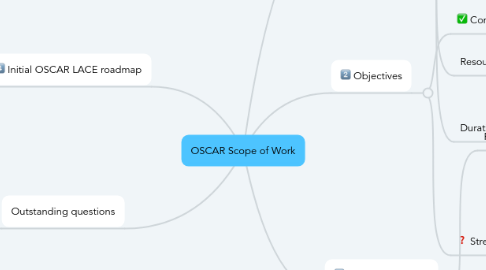
1. Initial OSCAR LACE roadmap
1.1. Onboard the coaches
1.1.1. Discovery and famiiarization
1.1.2. Join OSCAR CoE
1.1.2.1. Form Agile Coaching Stream
1.1.2.1.1. All Scrum Masters
1.1.2.2. Form program trios
1.1.2.2.1. Arch + Product Mgmt + SM Streams
1.2. Initialize Program Backlog
1.2.1. Single program product roadmap
1.2.1.1. Include Agile Coaching roadmap
1.2.2. organize around value
1.2.2.1. against Conway's Law
1.2.3. Product vision and roadmap review
1.2.3.1. initialize team backlog
1.2.3.2. facilitate creation
1.2.3.2.1. design sprint
1.2.4. build program kanban
1.2.5. Capacity allocation (features vs enablers)
1.2.6. Establish prioritization model (take an economic view)
1.2.7. Establish program board (team inter-dependencies mapping)
1.2.8. Prioritize backlog ready for program increment
1.3. Mobilize the team
1.3.1. Roles and responsibility review
1.3.2. Execuite Program Increment Planning
1.3.2.1. Start the train (team building event)
1.3.2.2. Business context, product mgmt vision (6R strategy), DevOps Architecture context
1.3.2.3. Establish PI objectives
1.3.2.3.1. establish capacity before historical data exists
1.3.2.4. Manage dependencies
1.3.2.5. Manage risks
1.3.3. Establish ALM (agile lifecycle Mgmt tool) (JIRA+Confluence+Slack)
1.3.4. Agile measurement
1.3.4.1. Baseline when mobilize the team
1.3.4.2. Monthly review for continuous improvement (every 2 iterations)
1.4. Start sprinting
1.4.1. Plan iteration with INVEST stories
1.4.1.1. create shared understanding
1.4.1.2. Demo driven planning
1.4.2. Visualize flow of work (Kanban, WIP)
1.4.3. Measure flow of work (charts, dashboard, velocity chart)
1.4.4. Build quality in (pair-programming, technical practices)
1.4.5. Continuously integrate, deploy and release
1.4.6. Refine the backlog continuously
1.4.7. Improve flow with comm and sync
1.4.8. Demonstrate value
1.4.8.1. validated learning
1.4.9. Retrospect and improve
1.4.9.1. Opportunities for growth
1.4.9.2. problem-solving workshop
1.5. Inspect, Adapt and Innovate
1.5.1. Program Level events
1.5.1.1. Scurm of Scrums
1.5.1.2. Product Owner Sync
1.5.2. Quantitative measures
1.5.3. Program predictability measure
1.5.4. Problem solving workshop
1.5.5. Early Spikes, Supplier showcases
1.5.6. Rotate Scrum Masters
1.5.6.1. scrum masters - cross-pollination
1.5.6.1.1. event-based exchange
1.5.6.2. post-stablization
2. Outstanding questions
2.1. Product roadmap
2.1.1. Any particular alignment
2.1.1.1. DevOps roadmap alignment
2.1.1.2. Cloud platform readiness milestones) to get optimum release timing
2.1.2. Any key milestones
2.1.2.1. Predictable events in the roadmap
2.1.3. Major dependencies
2.1.3.1. ETC testing
2.2. Component vs feature team
2.2.1. DevOps, Testing
2.2.2. dependence on I&O?
2.3. How to design the "program increment" (what milestones to hit?)
2.4. Do we need a system team?
2.4.1. any key cross team integration
2.5. Do we need "application" portfolio, by R-type?
2.6. What else (agile team formation / processes / practices) requires contextualization?
2.7. What is the story points / units to use?
2.7.1. vendor measurement?
2.7.1.1. task-hours actual tracking
3. Coverage
3.1. LACE Alignment
3.1.1. Karen + Jeff
3.1.2. Cultivate a Lean Agile culture
3.1.2.1. Embrace Lean-Agile as a journey, not a discrete activity
3.1.2.2. Lean Agile Leaders
3.1.2.2.1. Lead by example
3.1.2.3. Lean-agile mindset decision-making
3.1.3. Fosters community of Practice
3.1.3.1. lead process excellence
3.1.3.2. scrum masters, product owners
3.1.4. create consistency & alignment between lean-agile programs
3.1.5. Provide role-based agile coaching and training
3.1.6. establish objective agile metrics
3.1.6.1. objective milestones and reporting
3.1.7. Align with Agile PMO
3.1.7.1. governance
3.1.7.2. program execution
3.1.7.3. operational excellence
3.2. Resource
3.2.1. Senior Agile Coach
3.2.1.1. Daily Onsite
3.2.1.1.1. shadow key roles, show better than tell
3.2.2. Principle Agile Coach
3.2.2.1. One day per week
3.2.2.1.1. can be adjusted to be on-demand after 3 months
3.3. Duration
3.3.1. 6 months commitment with 3 months rolling forward
3.3.2. extension review every 3 months
4. Objectives
4.1. Commited
4.1.1. Create high performing agile teams
4.1.2. Coordinate and integrate agile teams and suppliers
4.1.3. Suppport value delivery with release train (team of teams)
4.1.4. Manage flow of value
4.1.5. Establish cadence and synchronization
4.1.6. Support program execution
4.1.7. Update Program and Product vision and roadmap
4.1.8. Define high level system attributes with features
4.1.9. Set priorities with backlog refinement
4.1.10. Guile innovation and exploration for program
4.2. Stretch
4.2.1. Build in quality and complaince
4.2.2. Apply lean agile estimating and forecasting on program level
4.2.3. Adapt governance practices to support agility and lean flow of value
5. Focus dimensions
5.1. Program agility
5.1.1. Requirement agility
5.1.1.1. Product Owner oriented
5.1.1.2. agile modeling and documentation
5.1.2. Process agility
5.1.2.1. Scrum Master role oriented
5.1.2.2. Agile Scrum practices and toolset
5.1.2.3. communication and collaboration
5.1.2.4. DevOps aa a cultural change and must involve everyone
5.1.3. Team agility
5.1.3.1. role and responsibility
5.1.3.2. vendor integration
5.1.3.3. level set lean agile practices
5.1.4. Continuous Learning
5.1.4.1. Agile Training, coaching, consulting
5.1.4.2. continuous inspect and adapt
5.1.5. Architectural/Design agility
5.1.5.1. Integrated Archtiecture roadmap into single product roadmap
5.1.5.2. Review migration/design patterns (replatform, rearchitect)
5.1.5.3. communicate with modeling
5.1.5.4. Apply intentional architecture
5.1.5.4.1. Welcome collaborative emergent design
5.1.6. Technical delivery agility
5.1.6.1. release deployment methods?
5.1.6.2. Test case/double = agile testing matrix
5.2. Business/Portfolio agility
5.2.1. Value stream flow agility
5.2.1.1. Accelerate flow
5.2.1.2. Build in quality and compliance with agile practices
5.2.2. Lean Portfolio Management LPM
5.2.2.1. Strategic alignment
5.2.2.1.1. Product Management for value delivery
5.2.2.2. Adjust value stream (project) budgets dynamically
5.2.2.2.1. Facilitate Lean Budgeting
5.2.2.3. Sequence epic/project implementation with WSJF (cost of delay/ job duration)
5.2.2.4. Measure portfolio performance
5.2.2.5. Coordinate continuous compliance
5.2.3. Agile procurement management
5.2.3.1. Agile contracting
5.2.3.1.1. Managed-Investment Contract
